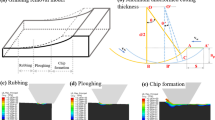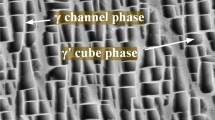Abstract
The rhenium element and grain boundaries have an essential effect on the dislocation slip generated during the grinding process of Ni-based superalloys. To study the impact of rhenium and grain boundaries on the grinding surface quality of Ni-based superalloys, the experiments were conducted with Ni-based polycrystalline superalloy GH4169 and Ni-based single-crystal superalloy DD5 (containing rhenium element) and DD98 (without rhenium element) as the research objects. The experiments with flat groove grinding as a machining method were conducted to explore the changes in surface roughness, grinding force, and surface morphology of the three Ni-based superalloys under different grinding parameters. The experiments show that the rhenium element significantly improves the high-temperature durability of Ni-based superalloys. In the relatively low-temperature condition (low grinding speed, considerable grinding depth, and high feed rate), the machining quality of DD5 is better than that of DD98, while in the relatively high-temperature condition, the machining quality of DD5 is lower than that of DD98. In the range of grinding parameters, the distortion of the subsurface microstructure of DD5 is lower than that of DD98. However, there is little difference between the two superalloys in chip morphology and serration. In high-temperature environments, grain boundaries become the weak link in Ni-based superalloys. The surface quality of GH4169 with grain boundaries is better than DD5, and its chip morphology differs significantly from DD5.














Similar content being viewed by others
Data availability
All data and materials used to produce the results in this article can be obtained upon request from the corresponding authors.
Code availability
Not applicable.
References
Miao Q, Ding WF, Kuang WJ, Yang CY (2021) Grinding force and surface quality in creep feed profile grinding of turbine blade root of nickel-based superalloy with microcrystalline alumina abrasive wheels. Chin J Aeronaut 34(2):576–585. https://doi.org/10.1016/j.cja.2019.11.006
Miao Q, Ding WF, Kuang WJ, Fu YC, Yin Z, Dai CW, Cao LJ, Wang HC (2022) Indentation behavior of creep-feed grinding induced gradient microstructures in single crystal nickel-based superalloy. Mater Lett 306:130956. https://doi.org/10.1016/j.matlet.2021.130956
Zhou YG, Wen XL, Yin GQ, Ma LJ, Tan YQ, Li HY (2021) Study on theoretical model of roughness and wear of the microgrinding tool in microgrinding nickel-based single crystal superalloy. J Braz Soc Mech Sci 43(6):1–15. https://doi.org/10.1007/s40430-021-03034-0
Cai M, Gong YD, Qu SS, Liu Y, Yang YY (2019) Experiment of grinding surface quality and subsurface microstructure for nickel-based single crystal superalloy. J Northeast Univ 40(3):386–391. https://doi.org/10.12068/j.issn.10053026.2019.03.016
Feng WH, Chang JX, Zhu SD (2021) Nickel-based single crystal superalloys with different rhenium contents. Chin J Rare Met 45(3):353–362. https://doi.org/10.13373/j.cnki.cjrm.XY20050020
Ding QQ, Yu Q, Li JX, Zhang Z (2018) Research progresses of rhenium effect in nickel-based superalloys. Mater Rep 32(1):110–115. https://doi.org/10.11896/j.issn1005-023X.2018.01.013
Ding WF, Miao Q, Li BK, Xu JH (2019) Review on grinding technology of nickel-based superalloys used for aero-engine. Chin J Mech Eng-En 55(1):189–215. https://doi.org/10.3901/JME.2019.01.189
Cai M, Gong YD, Feng LY, Liu JY (2019) Experimental study on grinding surface processing property of nickel-based superalloy. J Northeast Univ 40(2):234–238. https://doi.org/10.12068/j.issn.1005-3026.2019.02.016
Alves LOBDS, Ruzzi RDS, Silva RBD, Jackson MJ, Tarrento GE, Mello HJD, Aguiar PRD, Bianchi EC (2017) Performance evaluation of the minimum quantity of lubricant technique with auxiliary cleaning of the grinding wheel in cylindrical grinding of N2711 steel. J Manuf Sci E-T ASME 139(12):121018. https://doi.org/10.1115/1.4037041
Liang CY, Gong YD, Qu SS, Yang YY, Zhang H, Sun Y, Zhao JB (2022) Performance of grinding nickel-based single crystal superalloy: effect of crystallographic orientations and cooling-lubrication modes. Wear 508–509:204453. https://doi.org/10.1016/j.wear.2022.204453
Wu YR, Wang C, Luo J, Huang Y (2022) Experimental and numerical characterization of abrasive belt wear and debris formation during dry grinding of nickel-based superalloys with diamond abrasive belts. Simul Model Pract Th 118:102546. https://doi.org/10.1016/j.simpat.2022.102546
Hatami O, Adibi H, Rezaei SM (2022) Application of a compressed air jet for cleaning of wheel surface in grinding nickel-based super alloy Inconel 718. CIRP J Manuf Sci Tech 37:233–244. https://doi.org/10.1016/j.cirpj.2022.02.004
Cao Y, Ding WF, Zhao B, Wen XB, Li SP, Wang JZ (2022) Effect of intermittent cutting behavior on the ultrasonic vibration-assisted grinding performance of Inconel718 nickel-based superalloy. Precis Eng 78:248–260. https://doi.org/10.1016/j.precisioneng.2022.08.006
Wang ZL, Zou L, Duan L, Liu XF, Lv C, Gong MW, Huang Y (2021) Study on passive compliance control in robotic belt grinding of nickel-based superalloy blade. J Manuf Process 68:168–179. https://doi.org/10.1016/j.jmapro.2021.07.020
Tian L, Fu YC, Xu JH, Li HY, Ding WF (2015) The influence of speed on material removal mechanism in high speed grinding with single grit. Int J Mach Tool Manu 89:192–201. https://doi.org/10.1016/j.ijmachtools.2014.11.010
Ruzzi RDS, Paiva RLD, Silva LRRD, Abro AM, Silva RBD (2021) Comprehensive study on Inconel 718 surface topography after grinding. Tribol Int 158:106919. https://doi.org/10.1016/j.triboint.2021.106919
Qian N, Ding WF, Zhu YJ (2018) Comparative investigation on grindability of k4125 and inconel718 nickel-based superalloys. Int J Adv Manuf Tech 97(5–8):1649–1661. https://doi.org/10.1007/s00170-018-1993-y
Miao Q, Ding WF, Kuang WJ, Yang CY (2020) Comparison on grindability and surface integrity in creep feed grinding of GH4169, K403, DZ408 and DD6 nickel-based superalloys. J Manuf Process 49:175–186. https://doi.org/10.1016/j.jmapro.2019.11.027
Li BK, Ding WF, Li M, Zhang X (2021) Tool wear behavior of alumina abrasive wheels during grinding FGH96 powder metallurgy nickel-based superalloy. Procedia CIRP 101:182–185. https://doi.org/10.1016/j.procir.2020.04.161
Li BK, Dai CW, Ding WF, Yang CY, Li CH, Kulik O, Shumyacher V (2020) Prediction on grinding force during grinding powder metallurgy nickel-based superalloy FGH96 with electroplated CBN abrasive wheel. Chin J Aeronaut 34(8):65–74. https://doi.org/10.1016/j.cja.2020.05.002
Yazid MZA, CheHaron CH, Ghani JA, Ibrahim GA, Said AYM (2011) Surface integrity of Inconel 718 when finish turning with PVD coated carbide tool under MQL. Procedia Eng 19:396–401. https://doi.org/10.1016/j.proeng.2011.11.131
Li Q, Gong YD, Cai M, Liu MJ (2017) Research on surface integrity in milling Inconel718 superalloy. Int J Adv Manuf Technol 92(14):1449–1463. https://doi.org/10.1007/s00170-017-0080-0
Youssef S, Vidalenc Y, Calonne O, Hamdi H (2022) Microstructural and mechanical properties evolution of 690 nickel-based alloy subjected to severe hand disc grinding conditions. Mater Charact 194:112383. https://doi.org/10.1016/j.matchar.2022.112383
Shi ZM, Li BZ, Sun ZH (2022) Study on microstructure evolution of grinding surface of bcc Fe-Ni maraging steel based on molecular dynamics. Appl Surf Sci 573:151493. https://doi.org/10.1016/j.apsusc.2021.151493
Hao ZP, Lou ZZ, Fan YH (2021) Study on the evolution mechanism of subsurface defects in nickel-based single crystal alloy during atomic and close-to-atomic scale cutting. J Manuf Process 68:14–33. https://doi.org/10.1016/j.jmapro.2021.07.013
Ren J, Hao MR, Liang GX, Wang SY, Lv M (2019) Study of subsurface damage of monocrystalline nickel in nanometric grinding with spherical abrasive grain. Physica B 560:60–66. https://doi.org/10.1016/j.physb.2019.02.012
Li Q, Guo CG, Zhao LJ, Leng YF, Yue HT (2021) Milling force modeling of DD5 Ni-based single crystal superalloy with crystallographic anisotropic characteristics. China Mech Eng 32(6):734–740. https://doi.org/10.3969/j.issn.1004-132X.2021.06.014
Liu ZJ, Feng ZH, Wang HR, Zhang YP, Chen Z, Meng FC (2021) Atomic-scale investigation of the irradiation-resistant effect of symmetric tilt grain boundaries of Fe-Ni-Cr alloy. https://doi.org/10.48550/arXiv.2102.06907
Yu JG, Zhang QX, Yue ZF, Liu R (2015) Molecular dynamics simulation of dislocation and phase transition for ni-based superalloys with twist grain boundary. J Comput Theor Nanos 12:1002–1005. https://doi.org/10.1166/jctn.2015.3841
Liu CP, Zhang XN, Ge L, Liu SH, Wang CY, Yu T, Zhang YF, Zhang Z (2017) Effect of rhenium and ruthenium on the deformation and fracture mechanism in nickel-based model single crystal superalloys during the in-situ tensile at room temperature. Mater Sci Eng A-Struct Mate Prop Microstruct Process 682:90–97. https://doi.org/10.1016/j.msea.2016.10.107
Ding QQ, Li SZ, Chen LQ, Han XD, Zhang Z, Yu Q, Li JX (2018) Re segregation at interfacial dislocation network in a nickel-based superalloy. Acta Mater 154:137–146. https://doi.org/10.1016/j.actamat.2018.05.025
Fang X, Zhang J, Zhao YS, Yang ZY, Xu JW, Wu QH, Jiang H, Luo YS (2018) Effects of minor Re adjustment on microstructure and high-temperature stress rupture properties of the third generation Ni-based single crystal superalloy. Mater Mech Eng 42(1):33–38+43. https://doi.org/10.11973/jxgccl201801007
Luo YS, Liu SZ, Sun FL (2005) Status of study on strengthening mechanism of rhenium in single crystal superalloys. Mater Rep 19(8):55–58
Yue EL, Yu T, Wang YJ, Wang CY (2021) Synergistic strengthening mechanisms of rhenium in nickel-based single crystal superalloys. Intermetallics 132:107133. https://doi.org/10.1016/j.intermet.2021.107133
Huang M (2016) Zhu J (2016) An overview of rhenium effect in single-crystal superalloys. Rare Metal 35(2):127–139. https://doi.org/10.1007/s12598-015-0597-z
Sperry R, Harte A, da Fonseca JQ, Homer ER, Wagoner RH, Fullwood DT (2020) Slip band characteristics in the presence of grain boundaries in nickel-based superalloy. Acta Mater 193:229–238. https://doi.org/10.1016/j.actamat.2020.04.037
Long HB, Mao SC, Liu YN, Zhang Z, Han XD (2018) Microstructural and compositional design of Ni-based single crystalline superalloys - a review. J Alloys Compd 743:203–220. https://doi.org/10.1016/j.jallcom.2018.01.224
Tschopp MA, McDowell DL (2008) Grain boundary dislocation sources in nanocrystalline copper. Scr Mater 58(4):299–302. https://doi.org/10.1016/j.scriptamat.2007.10.010
Zhao X, Wang M, Hao XC, Zha XD, Gao M, Ma YC, Liu K (2021) Research progress in grain boundary serration in iron/nickel based austenitic polycrystalline alloys. Chin J Eng 43(10):1323–1338. https://doi.org/10.13374/j.issn2095-9389.2021.01.05.001
Zhang ZB, Yang ZB, Lu S, Harte A, Morana R, Preuss M (2020) Strain localisation and failure at twin-boundary complexions in nickel-based superalloys. Nat Commun 11:4890. https://doi.org/10.1038/s41467-020-18641-z
Seita M, Hanson J, Gradečak S, Demkowicz MJ (2015) The dual role of coherent twin boundaries in hydrogen embrittlement. Nat Commun 6:6164. https://doi.org/10.1038/ncomms7164
Wu XG (1990) Grain boundary structure and its effect on mechanical properties of polycrystalline materials (II). Adv Mech 20(2):159–173
Hanson JP, Bagri A, Lind J, Kenesei P, Suter RM, Gradečak S, Demkowicz MJ (2018) Crystallographic character of grain boundaries resistant to hydrogen-assisted fracture in Ni-base alloy 725. Nat Commun 9:3386. https://doi.org/10.1038/s41467-018-05549-y
Qu SS, Yao P, Gong YD, Yang YY, Chu DK, Zhu QS (2021) Modelling and grinding characteristics of unidirectional C-SiCs. Ceram Int 48:8314–8324. https://doi.org/10.1016/j.ceramint.2021.12.036
Sun Y, Jin LY, Gong YD, Wen XL, Yin GQ, Wen Q, Tang BJ (2022) Experimental evaluation of surface generation and force time-varying characteristics of curvilinear grooved micro end mills fabricated by EDM. J Manuf Process 73:799–814. https://doi.org/10.1016/j.jmapro.2021.11.049
Ma LJ, Gong YD, Chen XH (2014) Study on surface roughness model and surface forming mechanism of ceramics in quick point grinding. Int J Mach Tool Manu 77:82–92. https://doi.org/10.1016/j.ijmachtools.2013.11.001
Xu YC, Gong YD, Wang ZX, Wen XL, Yin GQ, Zhang H, Qi Y (2021) Experimental study of Ni-based single-crystal superalloy: microstructure evolution and work hardening of ground subsurface. Arch Civ Mech Eng 21:43. https://doi.org/10.1007/s43452-021-00203-9
Zhu T, Cai M, Gong YD, Gao XJ, Yu N, Li X (2022) Study on chip formation in grinding of nickel-based polycrystalline superalloy GH4169. Int J Adv Manuf Technol 121:1135–1148. https://doi.org/10.1007/s00170-022-09386-8
Gong YD, Zhou YG, Wen XL, Cheng J, Sun Y, Ma LJ (2017) Experimental study on micro-grinding force and subsurface microstructure of nickel-based single crystal superalloy in micro grinding. J Mech Sci Technol 31(7):3397–3410. https://doi.org/10.1007/s12206-017-0629-8
Funding
This work was supported by the National Natural Science Foundation of China (NO. U1908230&51775100), the Science and Technology Research Project of the Educational Department of Liaoning Province (No. LJKZ0384&L2017LQN024), the Talent Scientific Research Fund of LNPU (No. 2021XJJL-007).
Author information
Authors and Affiliations
Contributions
Ming Cai: writing — original draft, software, investigation, visualization, funding. Tao Zhu: writing — original draft, conceptualization, visualization. Yadong Gong: supervision, investigation, methodology. Xingjun Gao: conceptualization, methodology, formal analysis. Qiang Gong: data curation, formal analysis. Ning Yu: data curation, formal analysis.
Corresponding author
Ethics declarations
Ethical approval
The authors declare that there is no ethical issue applied to this article.
Consent to participate
The authors declare that all the authors have read and approved to submit this manuscript to IJAMT.
Consent for publication
The authors declare that all the authors agree to sign the transfer of copyright for the publisher to publish this article upon on acceptance.
Competing interests
The authors declare no competing interests.
Additional information
Publisher's note
Springer Nature remains neutral with regard to jurisdictional claims in published maps and institutional affiliations.
Rights and permissions
Springer Nature or its licensor (e.g. a society or other partner) holds exclusive rights to this article under a publishing agreement with the author(s) or other rightsholder(s); author self-archiving of the accepted manuscript version of this article is solely governed by the terms of such publishing agreement and applicable law.
About this article
Cite this article
Cai, M., Zhu, T., Gong, Y. et al. Study on the influence of rhenium and grain boundaries on the surface quality of Ni-based superalloys. Int J Adv Manuf Technol 125, 2363–2378 (2023). https://doi.org/10.1007/s00170-023-10915-2
Received:
Accepted:
Published:
Issue Date:
DOI: https://doi.org/10.1007/s00170-023-10915-2




